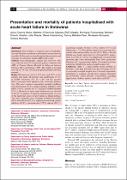| dc.identifier.citation | Mwita, J. C., Dewhurst, M. J., Magafu, M. G., Goepamang, M., Omech, B., Majuta, K. L., ... & Mashalla, Y. (2017). Presentation and mortality of patients hospitalised with acute heart failure in Botswana. Cardiovascular journal of Africa, 28(2), 112-117. | en_US |
| dc.description.abstract | Introduction: Heart failure is a common cause of hospitalisation
and therefore contributes to in-hospital outcomes such as
mortality. In this study we describe patient characteristics and
outcomes of acute heart failure (AHF) in Botswana.
Methods: Socio-demographic, clinical and laboratory data
were collected from 193 consecutive patients admitted with
AHF at Princess Marina Hospital in Gaborone between
February 2014 and February 2015. The length of hospital
stay and 30-, 90- and 180-day in-hospital mortality rates were
assessed.
Results: The mean age was 54 ± 17.1 years, and 53.9% of the
patients were male. All patients were symptomatic (77.5%
in NYHA functional class III or IV) and the majority
(64.8%) presented with significant left ventricular dysfunction.
The most common concomitant medical conditions
were hypertension (54.9%), human immuno-deficiency virus
(HIV) (33.9%), anaemia (23.3%) and prior diabetes mellitus
(15.5%). Moderate to severe renal dysfunction was detected
in 60 (31.1%) patients. Peripartum cardiomyopathy was one
of the important causes of heart failure in female patients.
The most commonly used treatment included furosemide
(86%), beta-blockers (72.1%), angiotensin converting enzyme
inhibitors (67.4%), spironolactone (59.9%), digoxin (22.1%),
angiotensin receptor blockers (5.8%), nitrates (4.7%) and
hydralazine (1.7%). The median length of stay was nine days,
and the in-hospital mortality rate was 10.9%. Thirty-, 90- and
180-day case fatality rates were 14.7, 25.8 and 30.8%, respectively.
Mortality at 180 days was significantly associated with
increasing age, lower haemoglobin level, lower glomerular
filtration rate, hyponatraemia, higher N-terminal pro-brain
natriuretic peptide levels, and prolonged hospital stay.
Conclusions: AHF is a major public health problem in
Botswana, with high in-hospital and post-discharge mortality
rates and prolonged hospital stays. Late and symptomatic
presentation is common, and the most common aetiologies
are preventable and/or treatable co-morbidities, including
hypertension, diabetes mellitus, renal failure and HIV. | en_US |

